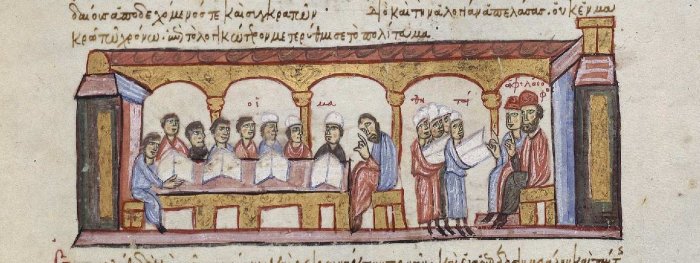The Field of Byzantine Archaeology and Art History

Defining the Field
The field of Byzantine Archaeology and Art History studies the material remains of Late Antique (beginning with the 3rd century CE) and Byzantine culture (up to the conquest of Constantinople in 1453 CE). In this period political and religious change brought the Imperial Age to an end. After the demise of Rome Constantinople became the centre of a new polity, the Byzantine Empire, which would be a neighbour and rival of the Latin West in politics and culture until its downfall. Education in Heidelberg focuses on the Late Antique / Early Byzantine and Middle Byzantine periods.
Describing the Field
1. Boundaries
The geographical area under examination comprises for Late Antiquity all the settlements and provinces of the Roman Empire and for the Byzantine Middle Ages mainly the eastern Mediterranean with the capital of Constantinople at its centre.
Byzantine Archaeology and Art History shares with other archaeological and art historical disciplines (mainly Classical Archaeology, Egyptology, Prehistorical and Near Eastern Archaeology) its focus on the material and archaeological record and the associated research methods. It differs from them though by the culture under examination. The later is shared with parts of Classical Philology and Ancient History on the one hand and Ecclesiastical and Medieval History on the other, although they differ in the nature of the evidence under consideration.
2. Objects of Study
The following kinds of objects and monuments are studied by Byzantine Archaeologists:
- Architecture, town planning and topography, graves and burial objects
- Visual arts (for example: mosaics, painting, sculpture)
- small artifacts, handicrafts, objects of everyday life
- Inscriptions
3. Methodology
The methodology of the field depends on the objects under consideration.
- The ability to record finds and findings is fundamental.
- The desired training in comparative vision is particularly demanded by the methods of iconography and form analysis.
- The interpretation of the findings in their historical context requires a basic knowledge of historical and philological methods.
4. Organisations
The field of Byzantine Archaeology and Art History is represented in two national associations: the Arbeitsgemeinschaft Christliche Archäologie zur Erforschung spätantiker, frühmittelalterlicher und byzantinischer Kultur as well as the Deutschen Arbeitsgemeinschaft zur Förderung Byzantinischer Studien. Students can participate in the conferences of both associations; in the former they can already become members during their education.
Current news on Byzantium can also be found on the home page of the Society for the Promotion of Byzantine Studies in London as well as the Centre d'Études Byzantines, Néo-Helléniques et Sud-Est Européennes in Paris.

